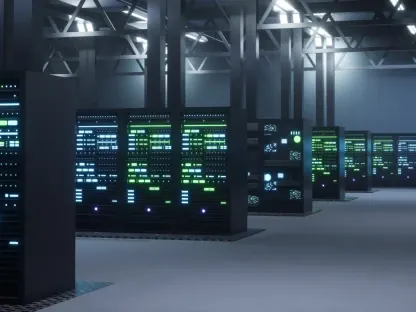The transformation of the energy sector is centered around the burgeoning smart grid technology, steering us toward a future of increased efficiency and eco-friendliness in energy usage. The integration of cutting-edge digital technology, sensors, and software is giving rise to sophisticated electric networks capable of managing electricity supply and demand in real-time. This breakthrough facilitates a delicate balance amidst rising energy use and the integration of renewable sources. Smart grids are essential for introducing a new era of grid stability, cost reduction, and environmental responsibility. They promise an impressive evolution in energy distribution without necessitating heavy investments in additional infrastructure. With these smart networks, the energy industry is setting the stage for a more dynamic, robust, and sustainable future.
The Pioneers Behind the Smart Grid Innovation
Leading the charge in smart grid transformation are innovative behemoths like Cisco, Siemens, IBM, Schneider Electric, and GE. These corporations are stirring the energy sector with their transformative approaches, signaling an age where consumers command their power generation ecosystems. Personal renewable energy implementations, from the ubiquity of rooftop solar panels, are smoothly integrated into the grid’s fabric, establishing a real-time energy dialogue. This integration champions a novel energy landscape where transparent production and consumption encourage enhanced management, reduced costs, and unwavering dependability—a testament to technological prowess meeting consumer empowerment.These pioneering forces are crafting the future with assertive strides. By converging their technological acumen and visionary outlook, they are creating scalable solutions where individual contributions to energy generation play a collaborative role with the grid. This synergy promises a democratized energy structure where every kilowatt produced by homeowners becomes a thread in the broader tapestry of a resilient and responsive electrical network. The result is a seismic shift in consumer utility, riding the wave of smart innovation toward a horizon of inimitable energy sovereignty.
Strengthening Grid Stability with Renewables
Smart grids are proving to be crucial in the integration of renewable energy into our power systems. These innovative networks deftly balance the unpredictable supply from wind and solar sources with the demands of a stable grid. By efficiently managing fluctuations and peak loads, smart grids help to prevent congestion and reduce electricity costs for consumers.With the growth of renewable energy, the role of smart grids becomes more important. They offer the advanced management needed to fully exploit the potential of green power while assisting in the protection of our environment. As the push for sustainability grows, smart grids are indispensable in ensuring consistent and reliable energy from renewable sources.This synergy between smart grids and renewable energy supports the goal of a seamless, eco-friendly power supply, signifying a resilient future for energy systems.
Enhanced Transmission Efficiency and Responsiveness
The efficiency of energy transmission has reached new heights under the stewardship of smart grids. Endorsed by the foresight of institutions like the International Energy Agency, these grids are revolutionizing how electricity is managed, diminishing inherent transmission losses via real-time digital technologies. Furthermore, their interactive capabilities significantly abridge the recovery arc in the wake of disturbances, ensuring swift service restoration and minimizing potential setbacks. The promptness and analytical finesse of smart grids provide an invaluable shock absorber to the inevitable jolts within our energy systems.This enhanced responsiveness is critical in weathering not only unforeseen outages but also routine maintenance issues that may arise within the electrical infrastructure. The rapid detection and preemptive resolution of faults by smart grids maintain the steadiness of energy flow and reduce service disruptions. With their predictive maintenance strategies, smart grids stand guard over the arteries of power, ensuring electrical health and robustness. The progressive march toward uninterrupted energy, regardless of bumps in the road, is emblematic of smart grids’ transformative impact.
Shielding the Grid from Cyber Threats
Smart grids, although more exposed to sophisticated cyber threats, are defended by robust security involving cutting-edge surveillance, encryption, and stringent access protocols. These measures constitute a multi-tiered defense system, underscoring the seriousness of protecting this vital infrastructure. As technology advances, so does the challenge to maintain an impenetrable shield around the networks that manage our energy delivery.Enhancing smart grid cyber resilience is a strategic endeavor where prevention and constant monitoring play key roles. With comprehensive safeguards and innovative defense tactics, the security and reliability of the smart grid’s data and operations are prioritized. In an era where cyber attacks are a tangible risk, the steadfastness of energy infrastructures not only assures a stable power supply but also secures the confidence of the communities that rely on it.
Achieving Economic and Environmental Milestones
Smart grids emerge as economic catalysts, driving down operational and managerial costs, thus translating into more affordable electricity for consumers. As smart grid components like smart meters become increasingly cost-effective, their palpable economic advantages augur well for the wallet and the wider market. And beyond the economics, the environmental dividends are equally potent. By optimizing the consumption and assortment of energy, smart grids lay the groundwork for a green ecosystem—ushering in a new chapter in carbon emission reduction and energy conservation by marrying the innovation of technology with staunch environmental stewardship.Economic frugality and eco-friendly virtues stand as two pillars within the smart grid ethos, each reinforcing the other in a virtuous cycle. Consumers, empowered by the means to participate in energy production and decision-making, are incentivized to adopt practices and technologies that drive down both costs and their carbon footprint. The proliferation of electric vehicles and the decentralization of energy generation are but two examples of the ripples extending from the central tenet of smart grids. This twofold boon continues to carve a niche for smart grids at the heart of a sustainable future.
Reliability as the Cornerstone of Smart Grids
Smart grids are integral to ensuring a reliable electricity supply that can automatically self-diagnose and heal. This advanced infrastructure instills confidence in its ability to deliver continual energy, vital for economic stability and progress. They act as protectors against power outages, supporting everyday life and business operations, making them essential to the energy framework of modern society.Beyond technical resilience, smart grids symbolize a trustworthy system capable of adapting to ever-changing energy requirements. This adaptability reinforces the assurance that our energy sources are not just secure but also ready to evolve. Smart grids, hence, are a beacon of a resilient, adaptable energy future.These grids combine the latest technological innovations with user-generated energy contributions, establishing a strong, efficient, and eco-friendly energy foundation. They are designed to prevent blackouts, promote cost efficiency, and support environmental sustainability. Smart grids are paving the way toward an energetic, sustainable future, reflecting our commitment to advancing energy solutions.









